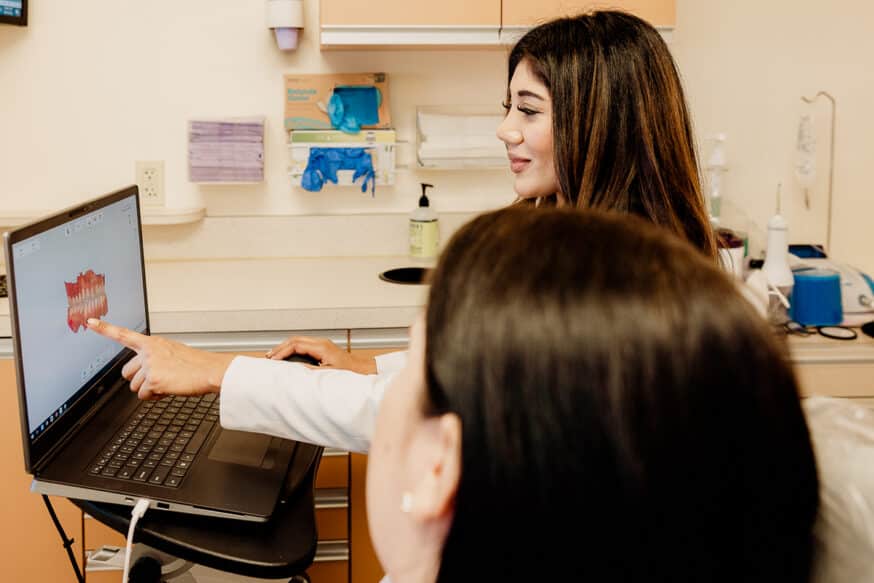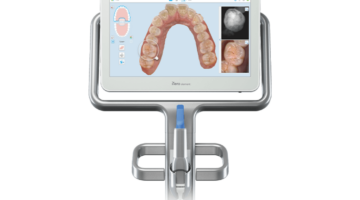New technology, including iPads, intraoral scanners, or new restoration materials can be overwhelming for patients—especially older adults and specifically geriatric dental patients Here’s how to help your patients feel comfortable with new technology and the recent improvements in dentistry.
It may seem unusual in these digital days, but some—from young to geriatric patients—aren’t familiar with or comfortable with new technology. For example, if a staff member hands a patient a tablet instead of a pen and a paper form at check-in, they may not know what to do. Assessing your patient’s familiarity with technology and assisting them will put patients at ease and help them prepare for a successful appointment.
Before the appointment: Assess the patient’s familiarity with computer technology and their ability to access a computer
Firstly, are they comfortable with handling communications through digital in the first place—you will gain more patients by going digital but you don’t want to lose any in the process, especially geriatric dental patients.
Do they have a computer with an internet connection at home?
Do they have an email account?
Do they have a smartphone or mobile device that will work with your platform?
Walk your patients through the process. Spend time with your geriatric dental patients so they feel comfortable
For patients who aren’t tech-savvy, send printed information and intake forms by mail. Ask patients to contact you if they have questions or if they have special needs before appointment time. Remember that some patients may require longer appointment times. Ensure your website and online tools are easy to use. Provide large text sizing and ensure your tablets are compatible with screen readers.
Offer to assist a patient using a computer tablet at check-in. Show the patient the app and demonstrate how to use it. Encourage them to ask questions if they become stuck. Patients will feel more comfortable using a hand-held device if they know they can ask questions.
What app features does the patient need for their appointment? Remember that too many on-screen choices can be confusing for patients.
When scheduling future appointments, ask the patient how they would like to be contacted; online, by email, or by giving them a completed appointment card.
Keep tech-savvy patients informed about app changes or updates
Inform your patients of platform changes or any actions they need to take before their next appointment.
Some patients, especially geriatric patients, may have extra challenges due to poor vision or hearing impairment. By making patient resources accessible and offering support, you’ll have happier patients.
Introducing patients, especially geriatric dental patients, to intraoral scanning
For patients, both geriatric and other who are new to digital dental technology they are used to traditional impressions, intraoral scanning is a new experience. While intraoral scanners make obtaining an oral impression easier, some patients may be nervous about having a brightly lit device in their mouth. Here’s a few ideas for making the scanning procedure more comfortable for patients
- Ask the patient questions before the procedure to assess their level of anxiety.
- Show the patient a video explaining the scanning procedure.
- Briefly explain the difference between a conventional impression (alginate) and a digital impression. Inform the patient that with an intraoral scanning procedure, they’ll be less likely to experience a gagging feeling or difficulty breathing.
- Mention that intraoral scanning is the most comfortable way to experience the procedure.
What if the patient asks if the intraoral scanner is safe?
A review by Jeffery B. Price, DDS, MS, Clinical Professor, and Director of Oral Radiology, states that intraoral scans are made with visible light radiation, not X-ray radiation. When compared to X-ray exposures, there is no risk with intraoral digital optical scans. The energy levels of electromagnetic radiation are low and there is no known risk to biological tissues. When the dentist scans your mouth, they are using visible light technology. This is the same technology used in smartphones and digital cameras.”
Are intraoral scanners safe for pregnant women?
Yes. As previously mentioned, intraoral scanning poses no more radiation risk than taking a selfie with a smartphone.
Increase case acceptance by sharing images with patients
Intraoral scanners transmit scanned images to a computer, which enables quick image viewing and sharing with your patients. Patients can clearly see what is happening inside their mouths instead of relying on a verbal explanation or viewing an X-ray.
Most intraoral scanners have a flexible arm, which allows the dentist to lower the viewing screen to the patient’s level. The patient can see what the dentist sees while suggesting and explaining a procedure.
Some intraoral scanners have a treatment simulator, which shows a patient’s post-procedure results using a scan of their teeth and gums. When patients can imagine positive results before the procedure, they’ll be more likely to accept a suggested treatment plan.
Intraoral scans vs. conventional impressions
A review focusing on the accuracy and reliability of images obtained from intraoral scanners compared to images obtained from conventional impressions concluded
“Inter- and intra-arch measurements from digital models produced from intraoral scans appeared to be reliable and accurate in comparison to those from conventional impressions. Digital models produced by intraoral scan eliminate the need for impressions materials; however, currently, more time is needed to take digital images.”
Zirconia restorations: Patient education and treatment acceptance
Zirconia became popular in the 2000s as a dental restorative. It’s often used as an alternative to porcelain-fused-to-metal restorations for patients who are allergic to PFM. More dentists are recommending zirconia crowns as an alternative to PFM and all ceramic materials, usually when restoring a single tooth.
Due to the material’s superior aesthetics, strength, and durability, zirconia is preferred by most dentists and patients.
Advantages of Zirconia Restorations
- Zirconia’s biocompatibility makes it ideal for dental applications
- It promotes healthy tissue response
- Excellent mechanical properties mean chipping and fracturing rarely occur
- For patients with metal allergies, zirconia is an excellent choice
- It’s easy to accurately match the patient’s natural tooth color
- The computer-aided design provides a more precise fit and a faster turnaround time
- Zirconia doesn’t transfer hot and cold temperatures like porcelain-fused-to-metal does – patients feel more comfortable with zirconia.
- Zirconia prevents darkening around the gingival area so no metal margins are exposed
- The strength and durability of zirconia make it preferable for patients with bruxism.
When discussing restoration options with your patients, especially geriatric dental patients, it’s important to provide the information they need to make the best choice. Make time to talk with the patient about available restoration options. Mention the preferred option first, and then listen.
Often, patients aren’t familiar with new technology. By providing information and assistance in a way that patients prefer, you’ll experience a boost in case acceptance, patient loyalty, and retention rates.
________________________________________________
Links used for research:
https://oceanceramics.com/blog/pfm-vs-pfzr-choosing-the-right-material-for-your-patient/
https://blog.ddslab.com/zirconia-dental-crowns-instead-of-pfm



